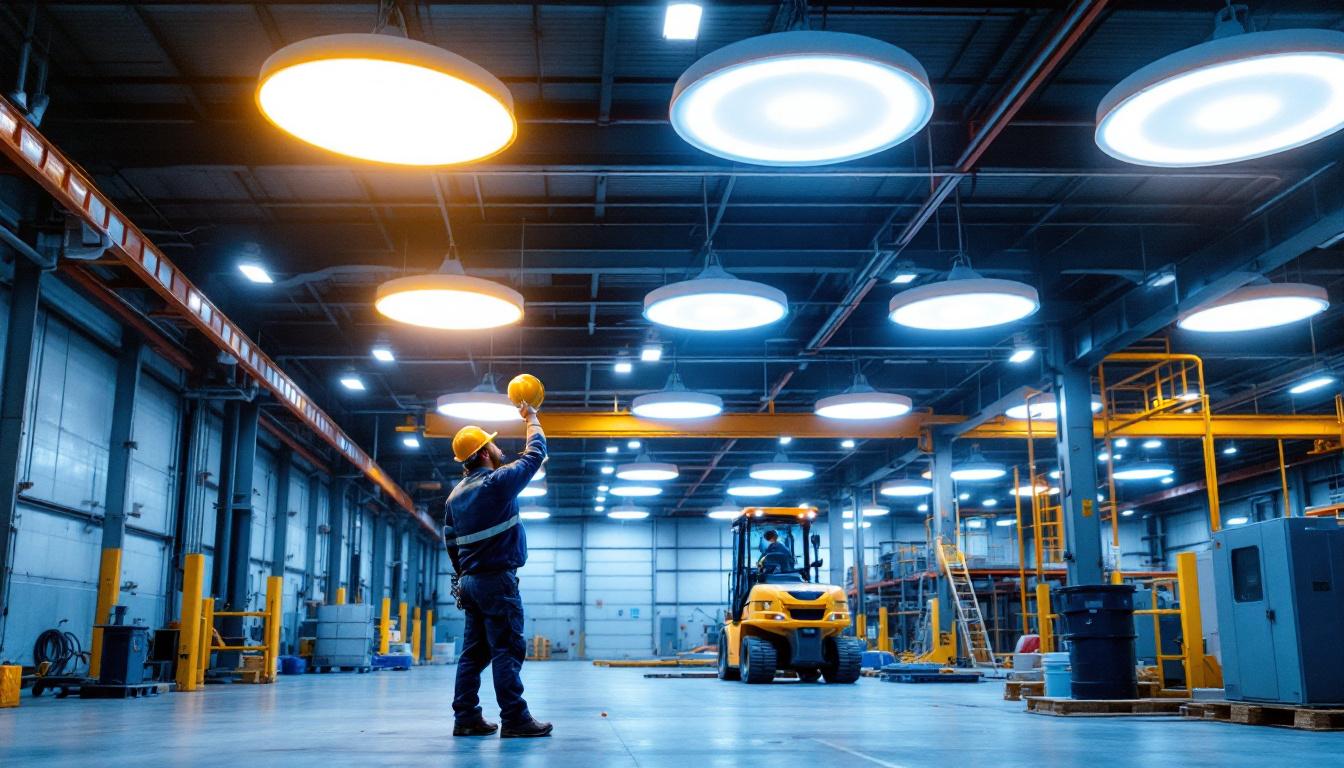
Dock lights play a crucial role in the functionality and safety of loading docks, warehouses, and other industrial spaces. These specialized lights are designed to provide adequate illumination during loading and unloading operations, ensuring that workers can perform their tasks efficiently and safely, even in low-light conditions. Understanding the various types and features of dock lights is essential for lighting contractors tasked with selecting the right products for their clients.
There are several factors to consider when choosing dock lights, including brightness, durability, energy efficiency, and ease of installation. Each of these elements contributes to the overall effectiveness of the lighting solution and can significantly impact the operational efficiency of a facility. For instance, a well-lit dock can reduce the risk of accidents, enhance productivity, and improve overall morale among workers, making the selection of appropriate lighting a critical decision for any industrial operation.
Dock lights come in various types, each designed for specific applications and environments. The most common types include LED dock lights, halogen dock lights, and fluorescent dock lights. LED dock lights are increasingly popular due to their energy efficiency and long lifespan. They provide bright illumination while consuming less power, making them an environmentally friendly choice. Moreover, many LED dock lights come with features such as motion sensors and dimming capabilities, which can further enhance energy savings and extend the life of the fixtures.
Halogen dock lights, on the other hand, offer high-intensity lighting but tend to consume more energy and have a shorter lifespan compared to LEDs. These lights are often favored for their ability to produce a warm light that closely resembles natural daylight, which can be beneficial for tasks requiring color accuracy. Fluorescent dock lights are another option, known for their ability to illuminate large areas effectively. However, they may not be as durable as LED options, especially in harsh industrial environments. Additionally, fluorescent lights can take time to warm up, which may not be ideal for operations that require immediate lighting upon activation.
When selecting dock lights, lighting contractors should pay attention to several key features. First and foremost is the brightness level, typically measured in lumens. Higher lumen output equates to brighter light, which is essential for ensuring safety during nighttime operations. It’s also important to consider the color temperature of the lights, as different temperatures can affect visibility and comfort levels for workers. A cooler color temperature may enhance alertness, while warmer tones can create a more inviting atmosphere.
Durability is another critical factor. Dock lights should be constructed from robust materials that can withstand the rigors of an industrial environment. Look for lights with weather-resistant ratings if they will be exposed to outdoor elements. Additionally, features such as adjustable arms and swivel heads can enhance the versatility of dock lights, allowing for better positioning and coverage. Some advanced models even offer remote control capabilities, enabling operators to adjust lighting from a distance, which can be particularly useful in busy or hazardous work areas. Furthermore, integration with smart technology can allow for real-time monitoring and adjustments, ensuring optimal lighting conditions at all times.
Energy efficiency is a significant concern for many businesses, especially in industrial settings where lighting can account for a substantial portion of energy costs. Choosing energy-efficient dock lights not only reduces operational expenses but also contributes to sustainability efforts. In an era where environmental responsibility is becoming increasingly important, businesses are under pressure to adopt practices that minimize their carbon footprint. Energy-efficient lighting solutions not only help in reducing energy consumption but also align with corporate social responsibility goals, making them an attractive option for companies looking to enhance their public image.
LED dock lights are the most energy-efficient option available, consuming significantly less power than traditional lighting solutions. Although the initial investment may be higher, the long-term savings on energy bills and reduced maintenance costs make them a wise choice for many businesses. Furthermore, LED technology has advanced rapidly, offering a variety of options that cater to specific needs, such as adjustable brightness and color temperature, which can improve visibility and safety in loading areas. This versatility makes LED dock lights not just a cost-effective solution but also a practical one, enhancing operational efficiency.
When evaluating the cost-effectiveness of different dock light options, contractors should consider the total cost of ownership. This includes the initial purchase price, installation costs, energy consumption, and maintenance expenses over time. By calculating the return on investment (ROI), contractors can provide clients with a clear picture of the long-term benefits of choosing energy-efficient lighting solutions. Additionally, it is important to factor in the potential for increased productivity due to better lighting conditions. Well-lit workspaces can lead to fewer accidents and improved employee morale, which can indirectly contribute to a company’s bottom line.
For instance, if a facility replaces outdated halogen dock lights with LED options, the reduction in energy consumption can lead to significant savings. Additionally, the longer lifespan of LED lights means fewer replacements and lower maintenance costs, further enhancing the ROI. Some studies suggest that businesses can save up to 75% on energy costs when switching to LED lighting, which can translate into thousands of dollars annually, depending on the scale of operations. This financial benefit, combined with the positive impact on workplace safety and efficiency, makes a compelling case for upgrading lighting systems.
Many utility companies and government programs offer incentives and rebates for businesses that invest in energy-efficient lighting solutions. Lighting contractors should be aware of these programs and inform their clients about potential savings. By taking advantage of available rebates, businesses can offset the initial costs of upgrading their dock lighting systems. These incentives can vary widely by region and may include tax credits, grants, or direct rebates on purchases, making it essential for businesses to conduct thorough research to maximize their savings.
Moreover, some states have implemented energy efficiency programs that not only provide financial incentives but also offer technical assistance and resources for businesses looking to improve their energy performance. By collaborating with local energy efficiency organizations, businesses can gain access to valuable information on best practices and innovative technologies. This proactive approach not only enhances the financial viability of energy-efficient upgrades but also fosters a culture of sustainability within the organization, encouraging ongoing improvements in energy management practices.
Proper installation is crucial for maximizing the effectiveness of dock lights. Lighting contractors should ensure that the installation process adheres to safety standards and guidelines. This includes proper mounting heights, angles, and spacing between lights to achieve optimal illumination.
Contractors should also consider the electrical requirements of the dock lights. Ensuring that the existing electrical infrastructure can support the new lighting system is vital. In some cases, upgrades to wiring or circuits may be necessary to accommodate more energy-efficient options.
Compliance with safety standards is paramount in industrial settings. Lighting contractors should familiarize themselves with relevant regulations and guidelines, such as those set forth by the Occupational Safety and Health Administration (OSHA) and the National Fire Protection Association (NFPA). These organizations provide valuable resources to ensure that lighting installations meet safety requirements.
Additionally, contractors should consider the specific needs of the facility, including any unique hazards or challenges. For example, if the dock area is prone to wet conditions, selecting waterproof or weather-resistant dock lights is essential to prevent electrical hazards.
The selection of a reliable supplier is a critical aspect of the lighting contractor’s role. A reputable supplier can provide high-quality products, expert advice, and ongoing support throughout the project. When evaluating potential suppliers, contractors should consider factors such as product range, warranty offerings, and customer service.
Quality should never be compromised when it comes to dock lights. Contractors should look for suppliers that offer products with proven performance and durability. Reading customer reviews and seeking recommendations from industry peers can provide valuable insights into the reliability of a supplier’s offerings.
Additionally, contractors should inquire about warranties and guarantees. A solid warranty can provide peace of mind, ensuring that any defects or issues will be addressed promptly by the supplier.
Establishing a strong relationship with suppliers can lead to better pricing, access to exclusive products, and priority support. Lighting contractors should communicate openly with suppliers about their needs and expectations, fostering a collaborative partnership that benefits both parties.
The lighting industry is constantly evolving, with new technologies and trends emerging regularly. Staying informed about these developments can help contractors make better decisions for their clients. One of the most significant trends in dock lighting is the increasing adoption of smart lighting systems.
Smart lighting solutions allow for enhanced control and automation, enabling facilities to adjust lighting levels based on occupancy or time of day. This not only improves energy efficiency but also enhances safety by ensuring that dock areas are well-lit when needed.
As smart technology becomes more prevalent, the integration of dock lighting with building management systems (BMS) is becoming increasingly common. This allows for centralized control of lighting, HVAC, and other systems, optimizing energy use and improving overall operational efficiency.
Contractors should explore the potential of smart dock lighting solutions and consider how they can integrate with existing systems. This forward-thinking approach can provide clients with a competitive edge and position contractors as industry leaders.
With growing awareness of environmental issues, sustainability is becoming a key focus for many businesses. Lighting contractors should consider the environmental impact of their choices, opting for energy-efficient products and sustainable practices. This not only aligns with corporate social responsibility goals but can also attract eco-conscious clients.
Incorporating sustainable practices into lighting projects can include using recyclable materials, minimizing waste during installation, and promoting energy-efficient solutions. By prioritizing sustainability, contractors can differentiate themselves in a competitive market.
Choosing the right dock lights is a critical decision for lighting contractors, impacting both safety and operational efficiency in industrial environments. By understanding the various types of dock lights, energy efficiency considerations, installation requirements, and trends in the industry, contractors can make informed choices that benefit their clients.
Building strong relationships with suppliers and staying updated on emerging technologies will further enhance the contractor’s ability to deliver high-quality lighting solutions. Ultimately, the right dock lighting not only illuminates workspaces but also contributes to a safer and more productive environment.
Ready to enhance your industrial environments with the best dock lighting solutions? Look no further than LumenWholesale for a superior selection of spec-grade lighting products. Our commitment to quality, affordability, and convenience ensures that you get the most reliable and high-performance lighting at wholesale prices. Say goodbye to inflated markups and hello to hassle-free bulk buying with free shipping. Choose LumenWholesale and experience the ideal combination of premium lighting and unbeatable value for your next project.

Explore the significance of the Di-Mlv-12V20W in modern lighting installations.

Discover the must-have 4ft fluorescent light fixtures that every lighting contractor needs in their toolkit.

Discover the pros and cons of flood light junction boxes for lighting contractors.

Discover the top UFO LED high bay lights with our comprehensive guide tailored for lighting contractors.